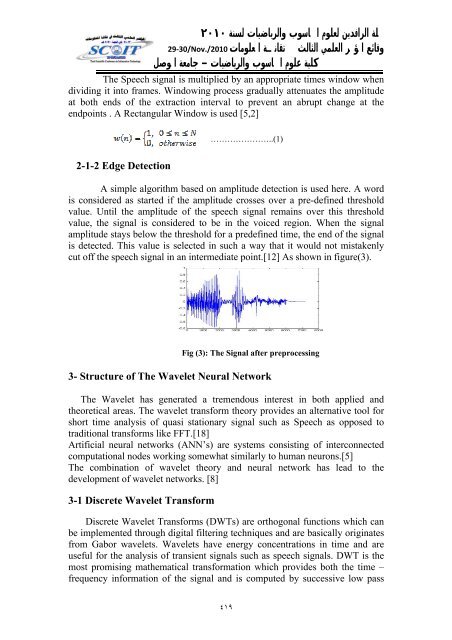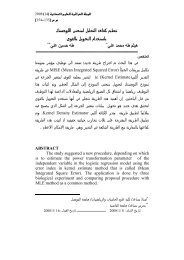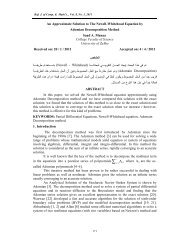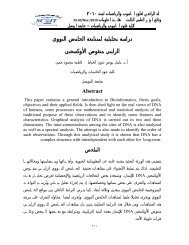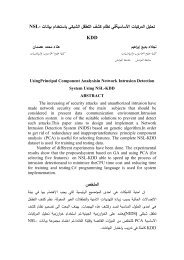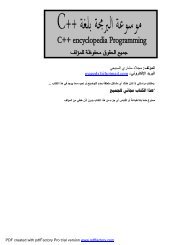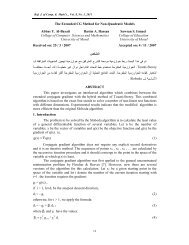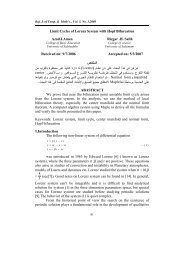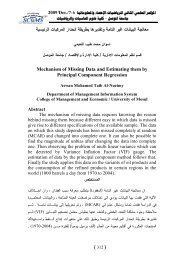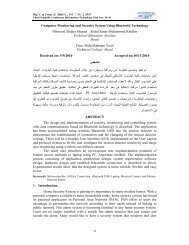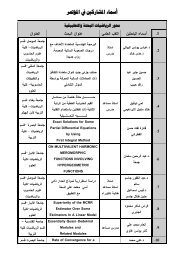arabic word recognition using wavelet neural network
arabic word recognition using wavelet neural network
arabic word recognition using wavelet neural network
You also want an ePaper? Increase the reach of your titles
YUMPU automatically turns print PDFs into web optimized ePapers that Google loves.
مجلة الرافدين لعلوم الحاسوب والرياضيات لسنة ٢٠١٠<br />
وقائع المؤتمر العلمي الثالث في تقانة المعلومات<br />
كلية علوم الحاسوب والرياضيات – جامعة الموصل<br />
29‐30/Nov./2010<br />
The Speech signal is multiplied by an appropriate times window when<br />
dividing it into frames. Windowing process gradually attenuates the amplitude<br />
at both ends of the extraction interval to prevent an abrupt change at the<br />
endpoints . A Rectangular Window is used [5,2]<br />
…………………..(1)<br />
2-1-2 Edge Detection<br />
A simple algorithm based on amplitude detection is used here. A <strong>word</strong><br />
is considered as started if the amplitude crosses over a pre-defined threshold<br />
value. Until the amplitude of the speech signal remains over this threshold<br />
value, the signal is considered to be in the voiced region. When the signal<br />
amplitude stays below the threshold for a predefined time, the end of the signal<br />
is detected. This value is selected in such a way that it would not mistakenly<br />
cut off the speech signal in an intermediate point.[12] As shown in figure(3).<br />
Fig (3): The Signal after preprocessing<br />
3- Structure of The Wavelet Neural Network<br />
The Wavelet has generated a tremendous interest in both applied and<br />
theoretical areas. The <strong>wavelet</strong> transform theory provides an alternative tool for<br />
short time analysis of quasi stationary signal such as Speech as opposed to<br />
traditional transforms like FFT.[18]<br />
Artificial <strong>neural</strong> <strong>network</strong>s (ANN’s) are systems consisting of interconnected<br />
computational nodes working somewhat similarly to human neurons.[5]<br />
The combination of <strong>wavelet</strong> theory and <strong>neural</strong> <strong>network</strong> has lead to the<br />
development of <strong>wavelet</strong> <strong>network</strong>s. [8]<br />
3-1 Discrete Wavelet Transform<br />
Discrete Wavelet Transforms (DWTs) are orthogonal functions which can<br />
be implemented through digital filtering techniques and are basically originates<br />
from Gabor <strong>wavelet</strong>s. Wavelets have energy concentrations in time and are<br />
useful for the analysis of transient signals such as speech signals. DWT is the<br />
most promising mathematical transformation which provides both the time –<br />
frequency information of the signal and is computed by successive low pass<br />
٤١٩


